Battle of Gaixia › Battle of Gaugamela › Clergy, Priests & Priestesses in Ancient Egypt » Origins and History
Articles and Definitions › Contents
- Battle of Gaixia › Origins
- Battle of Gaugamela › Origins
- Clergy, Priests & Priestesses in Ancient Egypt › Origins
Ancient civilizations › Historical places, and their characters
Battle of Gaixia › Origins
Definition and Origins
The Battle of Gaixia (202 BCE, also known as Kai-Hsia) was the decisive engagement of the Chu- Han Contention (206-202 BCE) at which Liu-Bang, King of Han, defeated King Xiang-Yu of Chu to found the Han Dynasty. After the death of Shi Huangti, the first emperor of a united China, his son Qin Er Shi took the throne and ruled so poorly that the country erupted in rebellion. Shi Huangti (formerly Ying Zheng of the state of Qin) had conquered the warring states of Chu, Han, Qi, Wei, Yan and Zhao to found the Qin Dynasty and ruled his empire rigorously. Qin Er Shi, who was ill-equipped to follow his father, was assassinated after three years and his nephew, equally inept, ascended the throne. During the years between Shi Huangti's death (210 BCE) and 206 BCE, the former subject states battled the toppling Qin regime, and sometimes each other, for supremacy. After the final defeat of the Qin army, two generals emerged victorious: Liu-Bang of the state of Han and Xiang-Yu of the state of Chu.
THE EARLY ALLIANCE
Liu-Bang and Xiang-Yu were equally skilled commanders and had each contributed significantly to the defeat of the Qin forces.Xiang-Yu had fought in more engagements while Liu-Bang was responsible for the final victory. Xiang-Yu was of noble birth and had taken the title `King of Western Chu' after assuming command of the troops. Liu-Bang was a commoner (though some sources cite him as a prince) but was raised to noble status by Xiang-Yu who conferred upon him the title `King of Han' with all attendant power. Xiang-Yu, claiming victor's rights and the superior position, then set about the redistribution of land and the ordering of the states but, in doing so, gave away lands which belonged to Liu-Bang. When Liu-Bang contested this decision he was ignored and, feeling dishonoured by his former ally, rallied his forces and attacked Xiang-Yu.
THE CHU-HAN CONTENTION
Between 206 and 202 BCE, the forces of the Han and the Chu battled each other with the additional states allying themselves now with one and now with the other. Shi Huangti had conquered the states by ignoring the old rules of chivalry concerning warfare and conducting a programme of total war ; this lesson was not lost on either Liu-Bang or Xiang-Yu. The Chu-Han Contention claimed thousands of lives and destroyed vast areas of farmland as well as urban areas.
Battles between the Han and the Chu forces raged until 203 BCE when Xiang-Yu negotiated a peace known as the Treaty of Hong Gate (also known as the Treaty of Hong Canal). Under the terms of the accord, China would be divided between the Han and the Chu. Liu-Bang signed the treaty but desired the same unification, and attendant glory, which Shi Huangti had achieved and, breaking the agreement, resumed hostilities. Xiang-Yu drove Liu-Bang back behind the defences of Han and besieged the central fortification. Liu-Bang orchestrated a three-pronged attack on Western Chu through the combined forces of the generals Han Xin the king of Qi and Peng Yue of the province of Liang. Xiang-Yu was forced to drop the siege to defend his homeland. Liu-Bang, however, had ordered Han Xin to circle back and harass the Chu forces during their march. Han Xin did far more than that and successfully ambushed Xiang-Yu and his army repeatedly. His goal, however, seems to have been to manipulate the large Chu force into the canyon at Gaixia where their numbers would work against them and they could be destroyed.
THE BATTLE AT GAIXIA
Xiang-Yu's young concubine, Yuji (born Yu Miaoyi), who always travelled with him on campaign, was captured during one of these engagements and Han Xin quickly conveyed her to Gaixia. He positioned his captive, and the bulk of his troops, deep in the canyon but situated other groups of warriors along the route. Xiang-Yu, knowing he was walking into a trap, mobilized his forces to save the woman he loved. He sent most of his army on toward his capital at Pengcheng and, with 100,000 warriors, marched for Gaixia.
Once Xiang-Yu's forces had fully entered the canyon, Han Xin deployed his troops in the “ambush from ten sides” and decimated the army. Xiang-Yu and his remaining forces fought on until nightfall, rescuing the Consort Yuji. Through the darkness then, Liu-Bang and Han Xin ordered their men and the captured enemy soldiers to sing the native songs of Chu.These songs reminded the remaining Chu forces of their homes and their families and further demoralized the army. Men began deserting in the darkness and headed for their homes. Xiang-Yu rose to stop them but, at the request of Yuji, relented and those who wished to were allowed to leave. He then sat drinking with Yuji and is said to have composed the lament, `The Song of Gaixia' (which is still sung today). Listening to the songs of his native land sung by the enemy throughout the night, Xiang-Yu believed that Western Chu must have fallen to the Han and his cause was lost. With Yuji, he sang his lament, alternating verses with her (according to the historian Sima Qian ). Yuji performed the sword dance as she sang and then, blaming herself for the Chu defeat, and wishing to save Xiang-Yu from further disaster through his love for her, she killed herself with his sword. Though surrounded by enemy forces, with his troops steadily deserting him, Xiang-Yu ignored the pleas of his counselors and buried Consort Yuji, erecting a large mound over her grave to prevent desecration.
By morning, Xiang-Yu had less than 800 men under his command but, with these fewer numbers, he was able to maneuver more easily and fought his way back out of the canyon of Gaixia. He headed directly for Pengcheng, the Han forces following quickly at his heels, and reached the Wu River where they caught up with him. A fierce battle ensued in which most of the Chu forces were slaughtered. Xiang-Yu fought to the end and, when he understood he would soon be captured, committed suicide by slitting his own throat with his sword. He was thirty years old.
LIU-BANG'S VICTORY & THE RISE OF THE HAN
Liu-Bang then proclaimed himself emperor, founding the Han Dynasty which would rule China from 202 BCE to 220 CE. He was known as the Emperor Gaozu and governed with his wife, the Empress Lu-Zhi. In time, he became suspicious of his old allies Peng Yue and Han Xin and had them both executed, under the pretext of spreading sedition, in 196 BCE. To divert blame from himself, he had the order come from Lu-Zhi.
The battle is among the most famous in Chinese history and the merits of the two antagonists, as well as their faults, are still debated. The story of Xiang-Yu and Yuji is the subject of the 1993 CE novel Farewell My Concubine by Lilian Lee, and the 1993 CE film by Chen Kaige of the same name, and has also been adapted as a popular opera. In 2011 CE the film Hong Men Yan, directed by Daniel Lee, was released (referencing the Feast of Hong Gate) based on the Chu-Han Contention and the Battle of Gaixia (the film's title in English is White Vengeance which has nothing to do with the Chinese title). Another feature film, The Last Supper, written and directed by Chuan Lu, was released in 2012 CE, depicting the battle and the story of Xiang-Yu and Yuji. The Tomb of the Concubine, Consort Yu's grave, is a highly regarded tourist attraction nine miles (15 km) east of modern Suzhou City in Lingbi County. The Chinese phrase, “surrounded by Chu songs” is derived from the Battle of Gaixia and refers to anyone in a hopeless situation.
Battle of Gaugamela › Origins
Definition and Origins
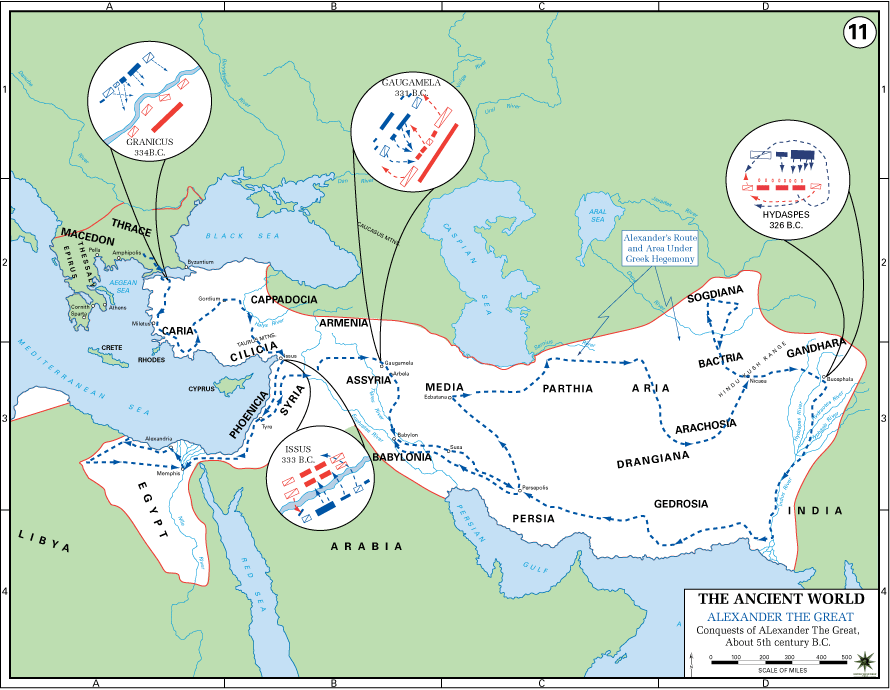
The Battle of Gaugamela (1st October 331 BCE, also known as the Battle of Arbela ) was the final meeting between Alexander the Great of Macedon and King Darius III of Persia. After this victory, Alexander was, without question, the King of all Asia.
Gaugamela (means "The Camel's House") was a village on the banks of the river Bumodus. The site of the battle is thought to be Tel Gomel (Hebrew - "Camels Mount") in northern Iraq.
Following the assassination of Phillip II, his father, in 336 BCE, Alexander and his army left their home of Macedonia for the last time and set out on a goal of conquering all of Persia. After crossing the Hellespont, Alexander travelled northward where he met and defeated the Persians under the leadership of the Greek mercenary Memnon at the Battle of River Granicus. As in future meetings with Alexander, Darius and his generals continually underestimated the abilities of the young Alexander. He was considered by many, even those in Greece, to be nothing more than an upstart.
From River Granicus Alexander moved southward along the coast of Asia Minor to Halicarnassus where he defeated Memnon for the second time. Finally, after waiting for over a year, Alexander and his forces met Darius at Issus in November of 333 BCE where, again, the Persians suffered defeat. Even more embarrassing for Darius was that Alexander captured his family -- his mother, wife and daughters. Wishing to avoid further conflict (and hoping to regain his family), Darius offered Alexander half of his kingdom and even his daughter's hand in marriage; however, Alexander rejected the offer by simply saying there could never be two suns -- it would upset world order. Alexander also challenged the Persian king to face him again in battle.
AFTER LAYING OUT PLANS FOR THE FUTURE CITY OF ALEXANDRIA & VISITING THE TEMPLE AT SIWA, ALEXANDER PREPARED FOR HIS NEXT ENGAGEMENT WITH DARIUS.
From Issus Alexander moved along the Mediterranean coast, capturing the island city of Tyre in a seven-month siege. As he travelled southward, he was welcomed in both Jerusalem and Egypt, for they had felt the wrath of the Persian army and the pangs of religious oppression. After laying out the plans for the future city of Alexandria and visiting the temple at Siwa, Alexander prepared for his next engagement with Darius.
Alexander had planned to march straight to Babylon, but when he learned of Darius' presence at Gaugamela, he turned northward to meet the waiting Persian king. He realized a victory at Gaugamela meant all of Persia -- Babylon, Persepolis, and Susa -- would be his.
Darius, however, had learned his lesson at the Issus and had carefully chosen Gaugamela for his next, and hopefully last, battle against Alexander. This time his army was quite different, having brought together men from all over his empire, even Indian mercenaries -- estimates of his army vary from 50,000 to 100,000 to almost a million. Along with fifteen elephants (although they were never used), he had two-hundred scythed chariots. He fashioned longer swords and lances as well as adding more cavalry. The terrain of Gaugamela was also significant -- it was much wider so he could make use of his chariots and deploy his cavalry more effectively -- something that had been impossible at Issus. He had the ground leveled, placing obstacles and traps to impede the advances of Alexander's forces. To Darius it appeared the size of his army and the terrain gave him a significant advantage.
Alexander made camp several miles from Darius; his men (estimated at 40,000) would only take their weapons to do battle, nothing else. After assembling a small scouting party, Alexander looked down from a hill, unobserved by Darius, accessing the king's preparation. Luckily, while on the scouting trip, he came upon an advance party sent out by Darius. While some of the party fled, several others were captured and more than willingly told of Darius' numbers and the presence of the traps and obstacles on the field.
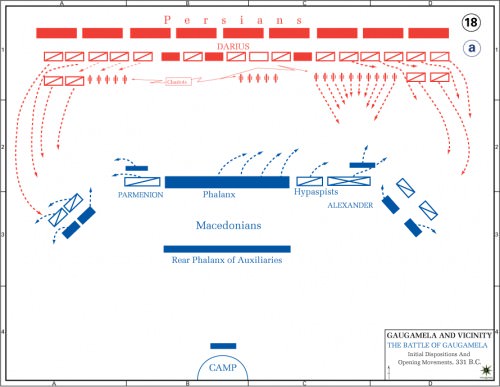
Map of the Battle of Gaugamela - Setup
The night before battle Alexander held a council of his generals; Parmenio, the commander of Alexander's left flank, suggested that the large size of Darius's forces called for them to attack at night; however, Alexander disagreed. The historian Arrian made mention of this episode in his History of Alexander :
It is said that Parmenio came to him in his tent and urged him to make a night attack on the Persians, saying that thus he would fall upon them unprepared and in a state of confusion … but the reply which he made to him … was that it would mean to steal a victory …
Later, as Alexander addressed his men, he spoke of the forthcoming battle, reassuring the typically superstitious Macedonians that an earlier eclipse of the moon was a sign of victory.
On the day of the battle Alexander is said to have overslept. As he had done previously, he made sure his men were well-fed and well-rested. Darius' men, on the other hand, had been awake all night fearing a night attack that never came. As Alexander looked across the battlefield towards the Persians, Alexander called out individual soldiers by name, speaking of their bravery in other battles and asking them to fight again for Macedonia. As he spoke an eagle (a favourite animal of Zeus ) flew overhead and towards Darius. To Alexander this was another omen of victory.
As in every other battle, Alexander and his companion cavalry took position on the right flank while Parmenio, as usual, held the left flank. Stationed in the middle were the well-trained Macedonian phalanx with more light infantry and archers on either side. Alexander also did something different; he chose to place infantry at angles on the ends of both the right and left flanks, to protect against a possible flanking maneuver by the Persians. He also placed additional Greek infantry to the rear of the center.
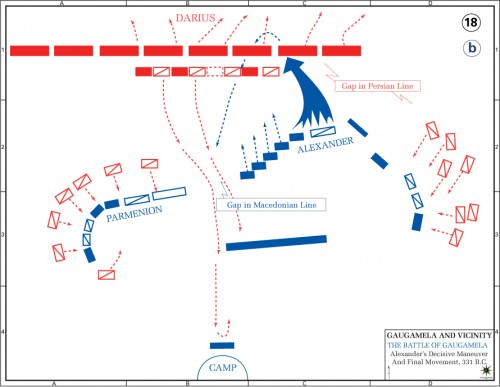
Map of the Battle of Gaugamela - Alexander's Attack
As the battle began, Alexander and his Companions immediately moved to the right at an oblique angle. Following Darius's orders, the Persians, under the leadership of Bessus, moved to their left, countering Alexander in an attempt to outflank him.As the Persians moved further and further to their left and into terrain that had not been cleared, an opening or gap was created. According to some historians, this entire move by Alexander had been a feint. Seeing the opening, Alexander formed his men into a wedge and quickly moved to his left and into the clearing, charging the shocked Darius.
While Alexander was challenging the Persians on the right, Darius sent his scythed chariots towards the Macedonian center, a move that failed to have the effect Darius had hoped. As the chariots approached, the phalanx merely opened ranks, allowing the chariots to pass through. The Persians were immediately set upon by the infantry and hand-to-hand combat soon followed.Back on the right, Alexander, spying Darius, seized upon the opportunity and threw a spear at the shocked king (missing him by inches). Just like at Issus, Darius realized that victory was hopeless and fled. Plutarch, in his Life of Alexander, spoke of Darius's flight:
Darius now seeing all was lost, that those who were placed in front of him were broken and beat back upon him, that he could not turn or disengage his chariot without great difficulty, the wheels being clogged and entangled among the dead bodies … was glad to quit his chariot and his arms, and mounting it is said, upon a mare that had been taken from her foal, betook himself to flight.
When the Persians on the left flank saw their king flee the battlefield, they quickly gave up the fight and were soon routed.
Clergy, Priests & Priestesses in Ancient Egypt › Origins
Ancient Civilizations
The ancient Egyptians understood that their gods had prevailed over the forces of chaos through the creation of the world and relied upon humanity's help to maintain it. The people of Mesopotamia held this same belief but felt they were co-workers with the gods, laboring daily to hold back chaos through even the simplest acts, but the Egyptians believed all they had to do was recognize how the world worked, who was responsible for its operation, and behave accordingly.
This behavior was directed by the central cultural value, ma'at (harmony and balance) which was sustained by an underlying force known as heka (magic). Heka (personified as the god Heka) had been present at the creation of the world, pre-existing the gods, and allowed those gods to perform their duties. All the people, by observing ma'at, helped to maintain the order established by the gods through heka, but a special class was responsible for honoring and caring for the gods daily, and this was the priesthood.
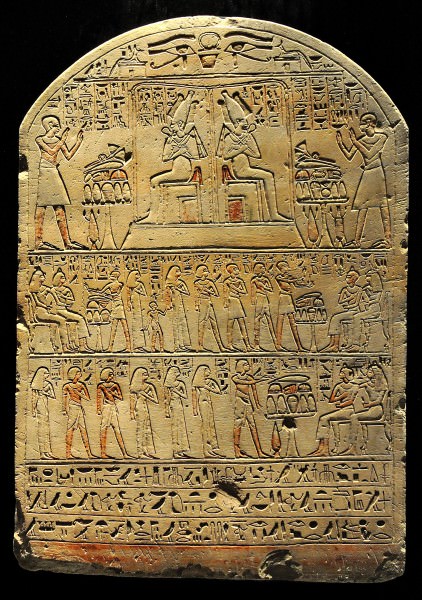
Stela of Roy and Kashisha
The clergy of ancient Egypt did not preach, interpret scripture, proselytize, or conduct weekly services; their sole responsibility was to care for the god in the temple. Men and women could be clergy, performed the same functions, and received the same pay. Women were more often priestesses of female deities while men served males, but this was not always the case as evidenced by the priests of the goddess Serket ( Selket ), who were doctors and both female and male, and those of the god Amun. The position of God's Wife of Amun, held by a woman, would eventually become as powerful as that of the king.
High priests were chosen by the king, who was considered the high priest of Egypt, the mediator between the people and their gods, and so this position had political as well as religious authority. The priesthood was already established in the Early Dynastic Period in Egypt (c. 3150-2613 BCE) but developed in the Old Kingdom (c. 2613-2181 BCE) at the same time as the great mortuary complexes like Giza and Saqqara were being constructed. Throughout Egypt's history, the priesthood would serve a vital role in maintaining religious belief and tradition while, at the same time, consistently challenge the authority of the king by amassing wealth and power which at times rivaled that of the crown.
TYPES OF PRIESTS
Male priests were known as hem-netjer and females as hemet-netjer (servants of the god). There was a hierarchy in the priesthood from the high priest ( hem-netjer-tepi, 'first servant of god') at the top to the wab priests at the bottom. The wabpriests carried out the essential but fairly mundane tasks of taking care of the temple complex and performing whatever function they were called upon for, such as helping to prepare for festivals.
In between these two positions was a wide array of priests who performed all kinds of duties in service to the gods: kitchen staff, janitors, porters, scribes, anyone who worked in the temple complex who had any association with the god was in some form a priest. Even the cult singers and musicians needed to have had some training in the priesthood to perform their duties, though probably not the kind of initiation or education which actual priests went through.
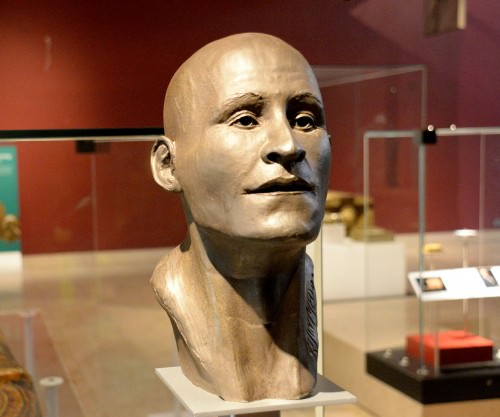
Head of the Egyptian Priest Iufenamun
The hour -priests were astronomers who kept the calendar, determined lucky and unlucky days, interpreted omens and dreams. There were the doctors, who were also priests, the swnw (general practitioner) and the sau (magical practitioner) who both combined medicine and magic. A ka -priest (also known as a ka -servant) was paid by a family to perform the daily offerings at the tomb of the deceased.
There were also sem priests who presided over mortuary rituals and conducted funeral services. Sem priests were the embalmers who mummified the corpse and recited the incantations while wrapping the mummy. The sem priests were highly respected because they were responsible for the precise utterance of the spells which would guarantee eternal life to the deceased. An interesting exception was the sem priest who would make the actual incision in the body to remove the organs.However he was treated the rest of the time, after this procedure, he was ritually insulted by his peers and chased down the road, most likely to ward off evil spirits associated with causing injury to the body.
Just below the high priest was the lector priest ( hery-heb or cheriheb ) who wrote down the religious texts, instructed other clergy, and recited the "authoritative utterance," the heka, in the temple and at festivals. Although there is evidence of women serving in all other positions in temple life, there is no record of a female lector priest. This could have been because the position was usually passed from father to son.
Besides the high priest, most of these positions were part-time. Priests and priestesses were divided into 'watches' and would serve the temple one month in every four. When their month of service was up, they returned to their regular jobs in the community which were usually those of mid-level bureaucrats. While they were in service, priests lived in the temple complex.They were expected to be ritually pure, bathe a number of times a day, and be able to carry out the duties required of them.
DUTIES & RITUALS
Although the details are unclear, the clergy had to undergo some kind of initiation ritual before assuming their position. It has been suggested that the Negative Confession, the list of sins one could honestly claim one had not committed, was originally part of this initiation ritual. By the time of the New Kingdom of Egypt (c. 1570-1069 BCE) the Negative Confession was entirely associated with judgment by Osiris in the afterlife and included in The Egyptian Book of the Dead but most likely developed earlier as an affirmation that a person was worthy of serving the god.
There were as many duties and rituals as there were priests, but the high-ranking clergy participated daily in two which were considered of utmost importance: Lighting the Fire and Drawing the Bolt. In the fire ritual, the priests would gather before dawn in a sacred room close to the god's shrine and re-enact the first appearance of the sun by lighting a fire in a brazier. The boat of the sun god was thought to pass through the underworld at night where it was threatened by the serpent Apophis.Rituals were often observed to help the sun god navigate his nightly trip safely and defeat Apophis and lighting the morning fire was among these.
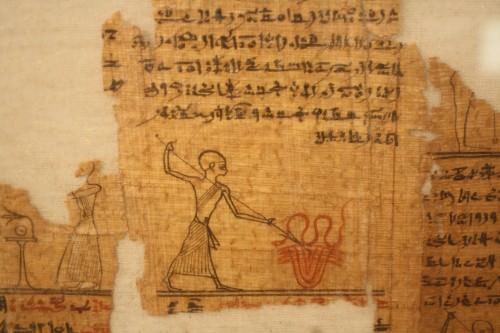
Book of the Dead
Following Lighting the Fire came Drawing the Bolt which was when the door was unlocked to the shrine room where the statue of the god resided. Only the high priest could enter this inner sanctum because it was believed the god or goddess lived in the statue and one was entering sacred space. The high priest was considered sanctified enough to share the presence of the god but no one else until the New Kingdom when the office of God's Wife of Amun was elevated under Ahmose I (c. 1570-1544 BCE). The God's Wife of Amun became the female counterpart of the high priest and some of the God's Wives had previously been high priestesses. The priest would wash and dress the statue, and then those of lesser rank would provide food and drink which was brought to the god and left in the room. When it was thought the god had supernaturally absorbed these offerings, they were removed from the room and dispensed to the temple staff.
FOR THE MOST PART, THE PEOPLE OF EGYPT INTERACTED WITH THEIR GODS PRIVATELY OR DURING THE MANY FESTIVALS HELD THROUGHOUT THE YEAR. THE PRIESTS SERVED THE GODS, NOT THE PEOPLE.
Throughout the day the priests, priestesses, singers, musicians, and others performed many different rituals at the temple and in the temple complex. One important feature of temples was the institution known as the Per- Ankh (House of Life) which was part library, writing center, scriptorium, conference center, and institute of higher learning. Religious and medical texts were written, copied, studied, and discussed there, and it may have been where young priests and doctors were educated. Besides activities at the Per-Ankh, rituals were performed to honor lesser deities associated with the main god of the temple, to honor deceased kings, queens, or other people of note, and to ensure fertility and health in the land.
None of these rituals involved a weekly service where the people would come to worship the god and hear the priest or priestess speak. The people already understood how the world worked and what was expected of them and did not need any ecclesiastical authority to instruct them. There is evidence that people came to the temple for help with medical, financial, and emotional needs as well as to request protection against evil spirits or ghosts, and it is also clear they would bring offerings to the temple in gratitude for prayers answered. For the most part, however, the people of Egypt interacted with their gods privately or during the many festivals held throughout the year. The priests served the gods, not the people.
EVOLUTION OF THE PRIESTHOOD
In time, however, the priests began to serve themselves more than either. There is evidence of this tendency beginning in the Old Kingdom of Egypt, actually, after the establishment of the grand royal necropolis at Giza. Giza in the Old Kingdom was not the lonely, wind-swept plateau of sand it is today, but a thriving community of state workers, merchants, craftsmen, and priests. These priests were responsible for providing the daily offerings and conducting the rituals which allowed for the continued journey in the afterlife of the kings.
One of the contributing factors to the collapse of the central government at the end of the Old Kingdom was that the king had exempted the priesthood from paying taxes. The priests not only lived off the offerings given to the gods but were able to profit from the land they owned, whose bounty was out of reach of the royal treasury. There is not a single period in Egyptian history in which this paradigm is not evident. It has been suggested, and is entirely probable, that the religious reforms of Akhenaten(1353-1336 BCE) in the New Kingdom were more of a political maneuver to undercut the power of the priesthood than a sincere effort at religious reform.
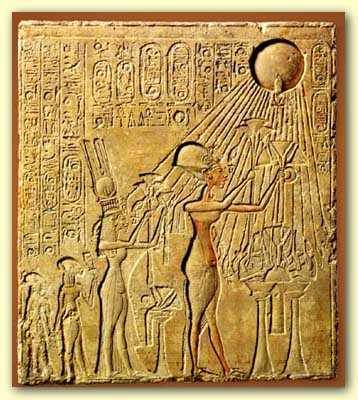
Akhenaten
By the time of Akhenaten, the cult of Amun had grown so powerful and wealthy that they rivaled the king. The position of God's Wife of Amun, held by royal women at the Temple of Karnak at Thebes, had begun as an honorary title in the late Middle Kingdom of Egypt (2040-1782 BCE) but, by the New Kingdom, was a powerful post, and in the Third Intermediate Period(c. 1069-525 BCE), the daughter of King Kashta (c. 750 BCE), Amenirdis I, effectively ruled Upper Egypt from Thebes as God's Wife. Akhenaten, who was probably not as mystically-inclined nor as politically inept as he is depicted, recognized the danger of the cult of Amun becoming too powerful and so tried to prevent this through the establishment of monotheism.
His efforts were in vain, however, not only because he was fighting against over 2,000 years of religious tradition but, on the purely practical level, too many people owed their livelihood to the temple and worship of the gods. After his death, his son Tutankhamun (c. 1336-1327 BCE) abolished his father's religion and returned to the old ways, and these reforms were completed by Horemheb (1320-1292 BCE) who erased Akhenaten's name from history in outrage at his impiety.
DEGENERATION & DISAPPEARANCE
The priesthood was therefore allowed to flourish and became especially powerful at Thebes. Amun increasingly was regarded as the King of the Gods and became the political power at Thebes through his grand temple at Karnak and the manipulations of the priesthood there.
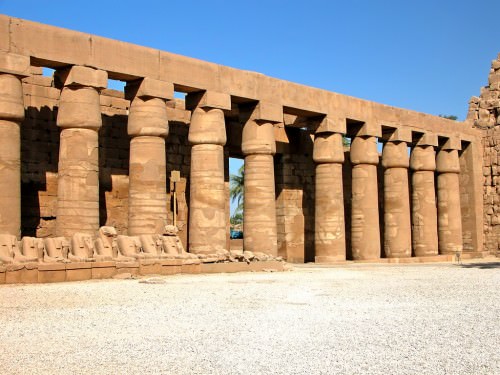
Temple of Amun, Karnak
According to scholar Marie Parsons, by the time of the reign of Ramesses III (1186-1155 BCE) in the later New Kingdom, the priests of the various cults held more power and wealth than the pharaoh ; especially the priests of Amun. Parsons writes:
During the reign of Ramesses III, the temple of Amun at Karnak comprised 433 orchards, 421,000 head of livestock, 65 villages, 83 ships and 46 workshops, with hundreds of acres of farmland, and a total labor force of more than 81,000. The temple of Ra at Heliopolis owned hundreds of acres, 64 orchards, 45,544 head of livestock, 103 villages, 3 ships and 5 workshops, with a personnel force of 12,700. The overseers of the estates and granaries, scribes, soldiers, all reported to the high priests of their temple. (4)
Just as Akhenaten may have feared, the power of the priests compromised the position of the king. In the Third Intermediate Period of Egypt, Amun was effectively the ruler of Thebes and Upper Egypt. Instead of the pharaoh interpreting the will of the gods for the people and acting as supreme high priest, the priests consulted the gods directly and interpreted their answers.Civic and criminals cases, matters of policy, domestic issues, building policies, were all decided at Thebes by Amun whose will was then interpreted and implemented by the priests. Egyptologist Marc van de Mieroop writes:
The god made decisions of state in actual practice. A regular Festival of the Divine Audience took place at Karnak when the god's statue communicated through oracles, by nodding assent when he agreed. Divine oracles had become important in the 18th Dynasty; in the Third Intermediate Period they formed the basis of governmental practice. (266)
Throughout the Third Intermediate Period and Late Period of Ancient Egypt (525-332 BCE), the priests continued to hold this level of power but the priesthood began to degenerate as offices were bought and sold. Egyptologist Margaret Bunson comments on this:
In time the priests would witness the downfall of their own shrines and temples and others of their ranks would enter the political world with ambitions. Even the role of the priesthood would be bartered away or squandered for gain. (209)
The priests maintained their position, with greater or lesser degrees of success, through the Ptolemaic Dynasty (332-30 BCE) and even into the later Roman Egypt, but by the time of the ascent of Christianity in the 4th century CE, they had lost most of their prestige and power and had largely betrayed their positions for material wealth and personal power. It was in partly because of the degeneration of the priesthood that Christianity was able to gain such influence in Egypt and eventually replace the old faith with a new one.
LICENSE
Article based on information obtained from these sources:with permission from the Website Ancient History Encyclopedia
Content is available under License Creative Commons: Attribution-NonCommercial-ShareAlike 3.0 Unported. CC-BY-NC-SA License